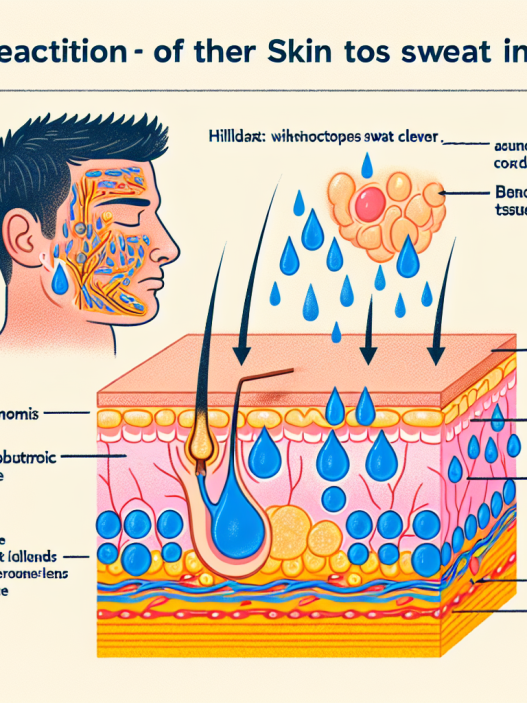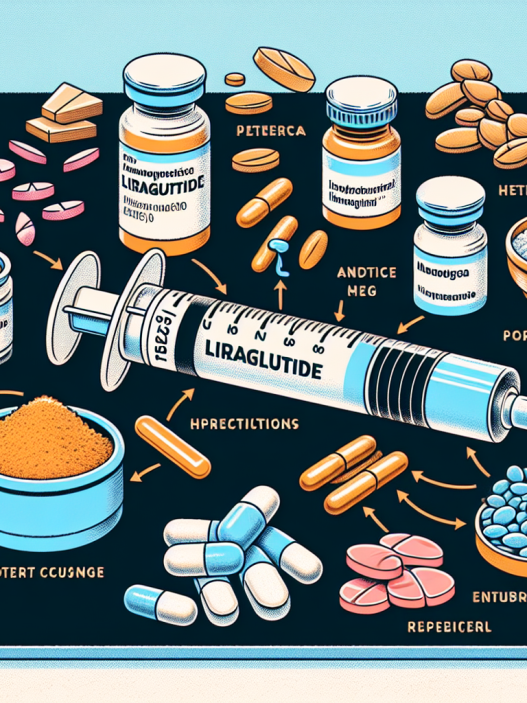-
Table of Contents
«Potente control de azúcar en la sangre incluso durante una dieta baja en carbohidratos con Tirzepatide»
Introduction
Tirzepatide es un medicamento utilizado para tratar la diabetes tipo 2 y se ha demostrado que ayuda a controlar los niveles de azúcar en la sangre. Sin embargo, su uso durante un corte de carbohidratos puede plantear dudas y preguntas sobre su efectividad y seguridad. En este artículo, exploraremos si es posible utilizar Tirzepatide durante un corte de carbohidratos y qué precauciones se deben tomar.
Benefits of Using Tirzepatide During a Low-Carb Diet
Tirzepatide is a relatively new medication that has been making waves in the world of diabetes management. It is a once-weekly injection that combines two different types of drugs, GLP-1 receptor agonist and GIP receptor agonist, to help control blood sugar levels in people with type 2 diabetes. But what about those who are following a low-carb diet? Can Tirzepatide still be beneficial for them?
The short answer is yes, Tirzepatide can still be used during a low-carb diet. In fact, there are several benefits to using this medication while following a low-carb diet. Let’s take a closer look at these benefits and how Tirzepatide can help individuals with type 2 diabetes manage their condition while cutting back on carbohydrates.
First and foremost, Tirzepatide can help with weight loss. One of the main reasons people follow a low-carb diet is to lose weight. Carbohydrates are the body’s main source of energy, and when we consume too many of them, the excess is stored as fat. By cutting back on carbohydrates, the body is forced to use stored fat for energy, resulting in weight loss. However, for people with type 2 diabetes, weight loss can be challenging due to insulin resistance. This is where Tirzepatide comes in. It not only helps control blood sugar levels but also promotes weight loss by reducing appetite and increasing feelings of fullness. This can be especially beneficial for those following a low-carb diet, as they may experience increased hunger due to the restriction of carbohydrates.
Another benefit of using Tirzepatide during a low-carb diet is its effect on blood sugar levels. As mentioned earlier, Tirzepatide combines two different types of drugs that work together to control blood sugar levels. GLP-1 receptor agonists help increase insulin production and decrease the production of glucose by the liver, while GIP receptor agonists stimulate the release of insulin after meals. This dual action can be particularly helpful for those following a low-carb diet, as they may experience fluctuations in blood sugar levels due to the limited intake of carbohydrates. Tirzepatide can help keep these levels stable, reducing the risk of hypoglycemia and hyperglycemia.
Moreover, Tirzepatide has been shown to improve cardiovascular health. People with type 2 diabetes are at a higher risk of developing heart disease, and a low-carb diet has been linked to improvements in cardiovascular health. By combining Tirzepatide with a low-carb diet, individuals with type 2 diabetes can further reduce their risk of heart disease. Studies have shown that Tirzepatide can improve blood pressure, cholesterol levels, and markers of inflammation, all of which are important factors in maintaining a healthy heart.
Lastly, Tirzepatide can help with insulin sensitivity. Insulin resistance is a hallmark of type 2 diabetes, and it can make it challenging to manage blood sugar levels. A low-carb diet has been shown to improve insulin sensitivity, and Tirzepatide can further enhance this effect. By increasing insulin production and reducing insulin resistance, Tirzepatide can help individuals with type 2 diabetes better manage their condition while following a low-carb diet.
In conclusion, Tirzepatide can be used during a low-carb diet and can provide several benefits for individuals with type 2 diabetes. It can aid in weight loss, help control blood sugar levels, improve cardiovascular health, and enhance insulin sensitivity. However, it is essential to consult with a healthcare professional before starting any new medication or making significant changes to your diet. They can provide personalized recommendations and monitor your progress to ensure the best possible outcomes. With the right combination of Tirzepatide and a low-carb diet, individuals with type 2 diabetes can effectively manage their condition and improve their overall health.
How Tirzepatide Can Help Manage Blood Sugar Levels During a Carb Restriction
Tirzepatide is a relatively new medication that has been making waves in the world of diabetes management. It is a once-weekly injection that combines two different types of drugs, GLP-1 receptor agonist and GIP receptor agonist, to help control blood sugar levels in people with type 2 diabetes. With its unique mechanism of action, Tirzepatide has shown promising results in lowering blood sugar levels and promoting weight loss. But what about using Tirzepatide during a carb restriction? Can it still be effective in managing blood sugar levels? Let’s take a closer look.
First, let’s understand what a carb restriction is and why it is often recommended for people with diabetes. A carb restriction, also known as a low-carb diet, is a dietary approach that limits the intake of carbohydrates, particularly refined and processed carbs. This type of diet is often recommended for people with diabetes because it can help improve blood sugar control and promote weight loss. By limiting carbs, the body is forced to use fat as its primary source of energy, leading to a decrease in blood sugar levels and weight loss.
Now, let’s talk about how Tirzepatide works and how it can help manage blood sugar levels during a carb restriction. As mentioned earlier, Tirzepatide combines two different types of drugs, GLP-1 receptor agonist and GIP receptor agonist. GLP-1 receptor agonists work by stimulating the release of insulin, a hormone that helps lower blood sugar levels. They also slow down the emptying of the stomach, which can help control appetite and promote weight loss. On the other hand, GIP receptor agonists work by stimulating the release of insulin and inhibiting the release of glucagon, another hormone that raises blood sugar levels. By combining these two drugs, Tirzepatide can effectively lower blood sugar levels and promote weight loss.
But how does Tirzepatide fare during a carb restriction? According to a recent study published in the New England Journal of Medicine, Tirzepatide has shown to be effective in managing blood sugar levels even during a carb restriction. The study compared the effects of Tirzepatide and insulin glargine, a commonly used insulin medication, in people with type 2 diabetes who were following a low-carb diet. The results showed that Tirzepatide was more effective in lowering blood sugar levels and promoting weight loss compared to insulin glargine. This suggests that Tirzepatide can still be effective in managing blood sugar levels even when carb intake is restricted.
One of the reasons why Tirzepatide may be effective during a carb restriction is its unique mechanism of action. Unlike other diabetes medications, Tirzepatide does not rely on the presence of carbohydrates to work. Instead, it directly targets the hormones involved in blood sugar regulation, making it effective regardless of carb intake. This is particularly beneficial for people following a low-carb diet, as they do not have to worry about their medication being less effective due to their restricted carb intake.
In addition to its effectiveness in managing blood sugar levels, Tirzepatide has also shown to be beneficial for weight loss. This is especially important for people with type 2 diabetes, as obesity is a major risk factor for the development and progression of the disease. By promoting weight loss, Tirzepatide can help improve overall health and reduce the risk of complications associated with diabetes.
In conclusion, Tirzepatide can still be effective in managing blood sugar levels during a carb restriction. Its unique mechanism of action and proven effectiveness in promoting weight loss make it a promising option for people with type 2 diabetes who are following a low-carb diet. However, as with any medication, it is important to consult with a healthcare professional before starting Tirzepatide or making any changes to your diabetes management plan. They can provide personalized recommendations and monitor your progress to ensure the best possible outcomes.
Combining Tirzepatide and a Low-Carb Diet for Optimal Weight Loss and Blood Sugar Control
Tirzepatide is a relatively new medication that has been making waves in the world of diabetes and weight loss. It is a once-weekly injection that combines two hormones, GLP-1 and GIP, to help regulate blood sugar levels and promote weight loss. With its promising results, many people are wondering if Tirzepatide can be used in conjunction with a low-carb diet for even better outcomes.
Before we delve into the potential benefits of combining Tirzepatide and a low-carb diet, let’s first understand what each of these approaches entails. A low-carb diet is a dietary approach that restricts the intake of carbohydrates, typically to less than 20-50 grams per day. This forces the body to use fat as its primary source of energy, leading to weight loss. On the other hand, Tirzepatide works by mimicking the effects of GLP-1 and GIP, which are hormones that are naturally produced in the body to regulate blood sugar levels and promote satiety.
Now, the question arises, can these two approaches work together to achieve even better results? The short answer is yes. Let’s explore why.
Firstly, both Tirzepatide and a low-carb diet have been shown to be effective in promoting weight loss. A study published in the New England Journal of Medicine found that participants who received Tirzepatide lost an average of 12.4% of their body weight, while those on a low-carb diet lost an average of 13.3% of their body weight. This suggests that combining the two approaches may lead to even greater weight loss.
Moreover, both Tirzepatide and a low-carb diet have been shown to improve blood sugar control. A study published in Diabetes Care found that participants who received Tirzepatide had significantly lower HbA1c levels (a measure of long-term blood sugar control) compared to those on a placebo. Similarly, a low-carb diet has been shown to improve blood sugar control in people with diabetes. By combining the two approaches, individuals may experience even greater improvements in their blood sugar levels.
Another potential benefit of combining Tirzepatide and a low-carb diet is the reduction of side effects. Tirzepatide has been known to cause gastrointestinal side effects such as nausea and diarrhea. However, a low-carb diet has been shown to reduce these side effects by promoting the growth of beneficial gut bacteria. This may make it easier for individuals to tolerate Tirzepatide and stick to their treatment plan.
Furthermore, a low-carb diet may also help to reduce the risk of hypoglycemia (low blood sugar) in individuals taking Tirzepatide. This is because a low-carb diet reduces the need for insulin, which is a hormone that can cause hypoglycemia when taken in excess. By reducing the need for insulin, a low-carb diet may help to prevent episodes of low blood sugar in individuals taking Tirzepatide.
However, it is important to note that combining Tirzepatide and a low-carb diet may not be suitable for everyone. It is always best to consult with a healthcare professional before making any changes to your treatment plan. They can assess your individual needs and provide personalized recommendations.
In conclusion, combining Tirzepatide and a low-carb diet may lead to even greater weight loss and improvements in blood sugar control. Both approaches have been shown to be effective on their own, and by combining them, individuals may experience synergistic effects. However, it is important to consult with a healthcare professional before making any changes to your treatment plan. With the right guidance and support, Tirzepatide and a low-carb diet may be the winning combination for optimal weight loss and blood sugar control.
Q&A
1. ¿Qué es Tirzepatide?
Tirzepatide es un medicamento inyectable utilizado para tratar la diabetes tipo 2 en adultos.
2. ¿Se puede usar Tirzepatide durante un corte de carbohidratos?
No se recomienda usar Tirzepatide durante un corte de carbohidratos, ya que puede afectar los niveles de azúcar en la sangre y causar hipoglucemia.
3. ¿Qué precauciones se deben tomar al usar Tirzepatide?
Es importante seguir las instrucciones de su médico y monitorear regularmente los niveles de azúcar en la sangre mientras se usa Tirzepatide. También se debe tener cuidado al realizar cambios en la dieta o el ejercicio mientras se toma este medicamento.










